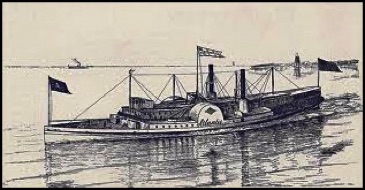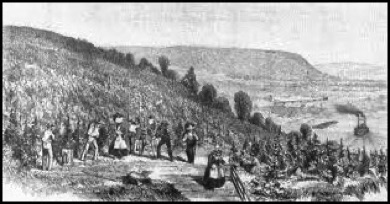
Many Darrtown families are of German heritage. Their family names resonate with the expression, "der Deutschland." Examples of such "Darrtown" family names include: Guiler, Kolb, Liebrich, Menke, Schmidt, Schultz, Uhl, Vinson, Wagonfield, and Weiss.



Given the number of German families that settled in and/or near Darrtown, it seems appropriate that this website address the subject of German immigration to America, Ohio, and Darrtown. No documents that are specific to persons who immigrated to Darrtown have been located. However, the resources that appear below provide a generic glimpse into the experiences of persons who immigrated to America during the 1800's.
If you have information to share about this topic, please inform the Webmaster.
Beyond having names that sound "German-like," genealogical research confirms that these Darrtown families, in fact, had roots in Germany.
...from Germany to America
The following was adapted from a website sponsored by the University of Illinois at Champaign/Urbana.
"Emigrant Ports and Vessels
In the early 1830s, the first spike in emigration from Germany occurred, and these emigrants favored the Bremen-to-Baltimore route to America. It was a route established on tobacco trade. Ships would carry emigrants to Baltimore and return with American tobacco for the European markets. The journey, on sailing ships, took about six weeks, longer in bad weather, and living conditions aboard these ships were appalling.

Between 1844 and 1847, there was another spike in emigration. This time emigrants preferred to enter America through New Orleans. The next stop was usually St. Louis. Two-thirds of the Germans arriving in St. Louis from 1848 to 1855 had come by way of New Orleans, the rest via the East Coast.
The Civil War blockade dealt New Orleans a near-fatal blow as an immigrant port. Afterwards, New York attracted increasingly greater proportions of immigrants regardless of their final destination. By then, railroad construction was booming and a traveler in New York could choose from three railroads for a thirty-six hour trip to Chicago.
Also at this time, Hamburg, Germany grew in importance as an emigration port because Eastern Europeans were immigrating in large numbers.
Even though Bremen and Hamburg served as the primary German ports of embarkation throughout the nineteenth century, the French port of Le Havre and the Low Country ports Antwerp and Rotterdam were also major points of departure. Also, many German immigrants were routed through England, so none of these ports can be ignored by one seeking the immigration route of an ancestor.
As to the issue of the emigrant using a sailing or steam ship, the timeline is critical and, yet, there was a significant overlap in the middle of the 1800s when both vessels plied the Atlantic.
1819 SS Savannah makes the first transatlantic crossing by a steamship.
1840 British Cunard Line establishes reliable transatlantic steamship line between Liverpool and Boston.
1870 About 88% of passengers chose steamships, which reduced the voyage to 12 to 14 days.
1879 The last sailing ship left Hamburg."
...from their port of entry to their new homes...
The following was adapted from a website sponsored by the University of Illinois at Champaign/Urbana.

"Once in America, the timeframe is again critical to how immigrants travelled from American ports to their final destination in Illinois.
Early immigrants hired wagons and remarkably walked at least part of the way, but river travel and later railroads were often part of the mix.
The following is a timeline of transportation in America, during the 1800's.
1807 Robert Fulton's Clermont went from New York City to Albany making history with a 150-mile trip taking 32 hours at an average speed of about 5 miles-per-hour.
1816 Henry Miller Shreve launched his steamboat, Washington, which completed the voyage from New Orleans to Louisville, Kentucky in twenty-five days. By 1853, the trip to Louisville took only four and one-half days.
1823 The steamboat, Virginia, was first to navigate the Mississippi from St. Louis to Ft. Snelling, Minneapolis.
1825 The Erie Canal completed.
1826 The first line of rails in the New England States is said to have been laid down at Quincy, Massachusetts.
1827 The Baltimore and Ohio Railroad is chartered to run from Baltimore to the Ohio River in Virginia. It was the first westward bound railroad in America.
1814-1834 New Orleans steamboat arrivals increased from 20 to 1,200 a year. The trip took 12 to 14 days and the boats transported cargoes of cotton, sugar, and passengers. In 1830, passage from New Orleans to St. Louis cost $30; deck passage was $8.
1833 Eleven steamboats were traveling regularly from Buffalo to Detroit on Lake Erie.
1835 An estimated 1,200 passengers a day left Buffalo. In 1840, the trip from Buffalo to Chicago cost $20. In 1850 it cost 0 and took about 9 days.
1855 The first land grant railroad in the U. S. is completed. The Illinois Central arrives in Dunleith, Illinois (now East Dubuque).
1856 The first railroad bridge across the Mississippi River is completed between Rock Island, Illinois and Davenport, Iowa.
1850 to 1860 Railroad mileage in Illinois increased from 110 to 2,867 miles.
1862 President Abraham Lincoln signs the Pacific Railway Act, which authorizes the construction of the first transcontinental railroad.
1869 The Central Pacific and Union Pacific meet at Promontory Summit, Utah for the driving of the golden spike on May 10th.
1870 Railroads supplanted steamboats as the major transporter of both goods and passengers, and the number of steamships exceeds the number of sailing vessels on the Great Lakes."
German Immigration to Ohio
Click the following link to visit the WOUB website, which is devoted to the topic of German culture in southern Ohio. See: "The Silent Majority: What is left of German Culture in Southern Ohio?"
